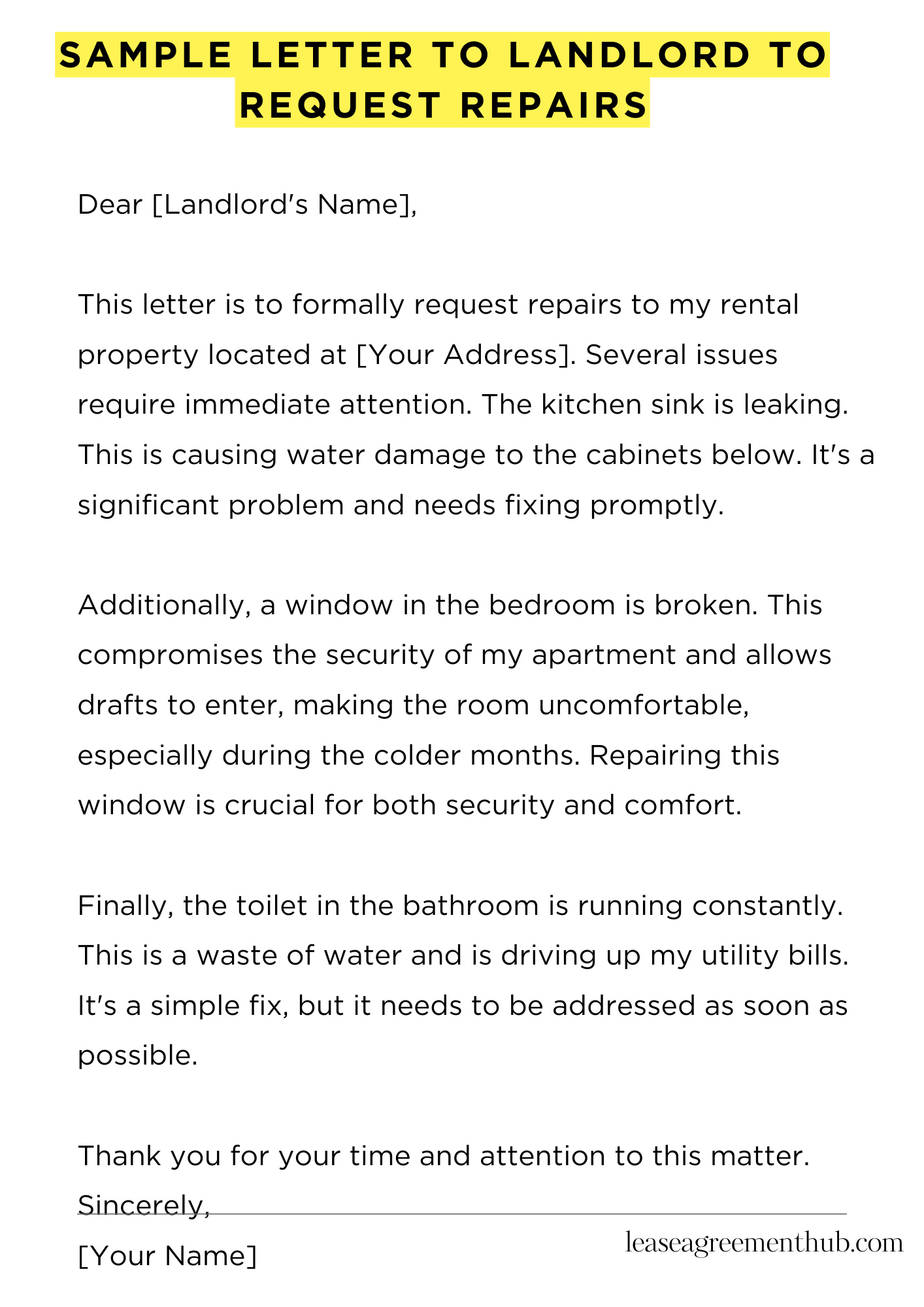Dealing with a broken toilet? Leaky roof? A sample letter to your landlord requesting repairs helps you formally report the problem. It ensures a clear record of your request.
This article provides several examples. You’ll find different letter templates. These cover various repair issues. They make writing your own letter much easier.
Use these samples as a guide. Adapt them to your situation. You can easily create a professional request. You can get your repairs done quickly.
Sample Letter to Landlord to Request Repairs
[Your Name]
[Your Address]
[Your Phone Number]
[Your Email Address]
[Date]
[Landlord’s Name]
[Landlord’s Address]
Dear [Landlord’s Name],
This letter is to formally request repairs to my rental property located at [Your Address]. Several issues require immediate attention. The kitchen sink is leaking. This is causing water damage to the cabinets below. It’s a significant problem and needs fixing promptly.
Additionally, a window in the bedroom is broken. This compromises the security of my apartment and allows drafts to enter, making the room uncomfortable, especially during the colder months. Repairing this window is crucial for both security and comfort.
Finally, the toilet in the bathroom is running constantly. This is a waste of water and is driving up my utility bills. It’s a simple fix, but it needs to be addressed as soon as possible.
I would appreciate it if you could arrange for these repairs to be completed within the next week. Please contact me at your earliest convenience to schedule a time for a repair person to visit. Thank you for your time and attention to this matter.
Sincerely,
[Your Name]

How to Write a Sample Letter to Landlord to Request Repairs
The Indispensable Salutation: Setting the Tone
Begin your correspondence with a formal salutation. Avoid colloquialisms. “Dear [Landlord’s Name]” is perfectly acceptable and establishes a professional tone from the outset. This initial step, seemingly inconsequential, significantly impacts the overall efficacy of your communication.
Articulating Your Grievances with Precision: Detail is Paramount
Clearly and concisely outline the specific repairs required. Ambiguity is the nemesis of effective communication. Use precise language, avoiding vague terms like “broken” or “damaged.” Instead, specify the nature of the defect. For example, instead of writing “the sink is broken,” write “the sink’s faucet is leaking profusely, necessitating immediate repair.” Include the location of the problem within the property for unequivocal clarity. This meticulous detail enhances the landlord’s understanding and expedites the resolution process.
Providing Contextual Information: A Necessary Precursor
Offer a succinct account of the issue’s genesis. When did the problem manifest? Did a prior incident precipitate the damage? Providing this background information contextualizes your request, lending it credence and highlighting the urgency of the situation. This proactive approach demonstrates responsibility and fosters a more collaborative approach to problem-solving.
Attaching Supporting Documentation: Fortifying Your Case
If possible, include photographic or video evidence of the damage. A picture, as the adage goes, is worth a thousand words. Visual documentation substantiates your claims, leaving no room for misinterpretation or obfuscation. This is particularly pertinent for more significant or complex repair requests.
Stating Your Expectations: Setting Realistic Deadlines
Politely, yet firmly, express your expectation for timely repairs. While maintaining a courteous demeanor, it’s crucial to assert your rights as a tenant. Suggest a reasonable timeframe for the completion of the repairs, bearing in mind local regulations and the complexity of the work involved. This proactive approach demonstrates your commitment to a swift resolution.
Concluding with Professionalism: A Graceful Exit Strategy
End your letter with a professional closing, such as “Sincerely” or “Respectfully.” Include your contact information, ensuring the landlord can easily reach you to schedule repairs or discuss the matter further. A well-crafted closing reiterates your seriousness and professionalism.
Maintaining a Paper Trail: Preserving Evidence
Retain a copy of the letter for your records. This serves as irrefutable evidence of your communication with the landlord should any disputes arise concerning the repairs. This proactive measure protects your interests and safeguards against potential future complications. Consider using certified mail with return receipt requested for added security.
FAQs about sample letter to landlord to request repairs
Writing an effective letter to your landlord requesting repairs can ensure your concerns are addressed promptly. Here are some frequently asked questions to help guide you.
What information should I include in my repair request letter?
Your letter should clearly state the nature of the repair needed, its location within the property, and the date you first noticed the problem. Include your contact information (name, apartment number, phone number, and email address). It’s also helpful to briefly describe the impact the issue is having on you.
How formal should my tone be in the letter?
Maintain a polite and professional tone throughout your letter. Avoid accusatory or demanding language. A respectful and courteous approach is more likely to result in a positive response from your landlord.
Do I need to send the letter via certified mail?
While not always mandatory, sending your letter via certified mail with return receipt requested provides proof that your landlord received your request. This can be helpful if they fail to respond or complete the repairs in a timely manner.
What should I do if my landlord fails to respond or make the repairs?
If your landlord doesn’t respond within a reasonable timeframe (check your lease agreement for specific guidelines) or fails to address the necessary repairs, you should follow the procedures outlined in your lease agreement or your local tenant laws. This might involve contacting your local housing authority or pursuing legal action.
What if the needed repairs are urgent and pose a safety hazard?
For urgent repairs that pose a safety hazard (e.g., gas leak, major plumbing issue), contact your landlord immediately by phone and in writing (email or letter). If the problem remains unresolved, you may need to contact emergency services or your local housing authority.
Related: